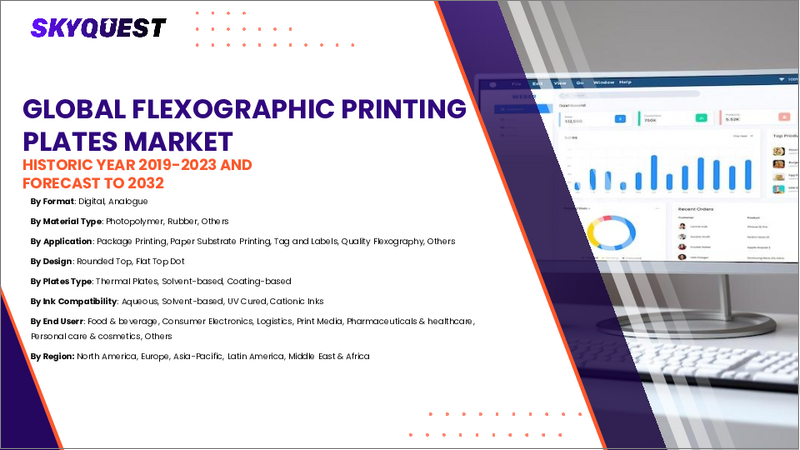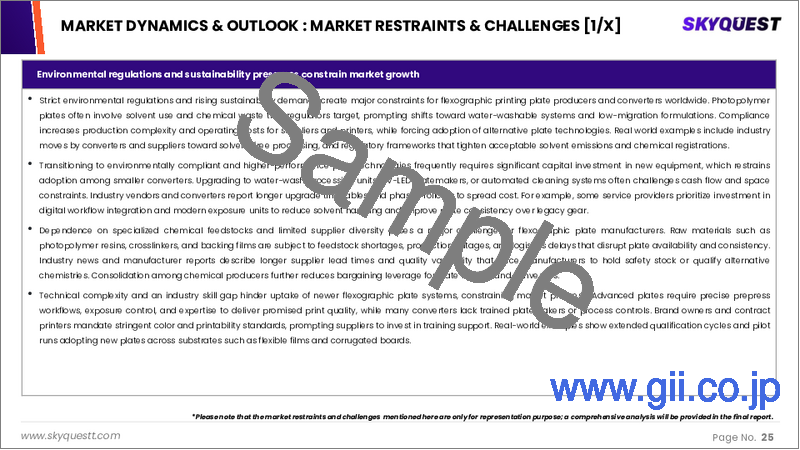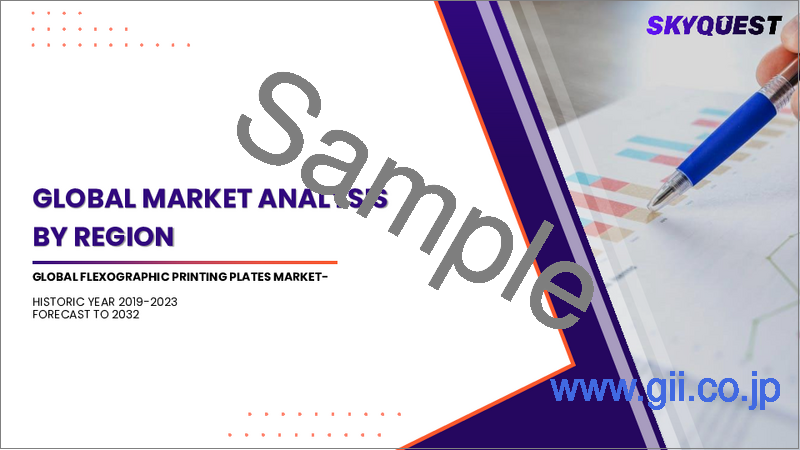|
|
市場調査レポート
商品コード
1629013
フレキソ印刷版の市場規模、シェア、成長分析、フォーマット別、タイプ別、用途別、デザイン別、インキ適合性別、地域別 - 産業予測、2025~2032年Flexographic Printing Plates Market Size, Share, Growth Analysis, By Format (Digital, Analog), By Type (Thermal Plates, Solvent-based), By Application, By Design, By Ink Compatibility, By Region - Industry Forecast 2025-2032 |
||||||
|
|||||||
| フレキソ印刷版の市場規模、シェア、成長分析、フォーマット別、タイプ別、用途別、デザイン別、インキ適合性別、地域別 - 産業予測、2025~2032年 |
|
出版日: 2025年01月06日
発行: SkyQuest
ページ情報: 英文 335 Pages
納期: 3~5営業日
|
全表示
- 概要
- 目次
フレキソ印刷版の世界市場規模は2023年に8億米ドルと評価され、2024年の8億6,000万米ドルから2032年には15億1,000万米ドルに成長し、予測期間(2025-2032年)のCAGRは7.3%で成長する見通しです。
フレキソ印刷市場は、性能向上への注目の高まりにより、著しい技術進歩が見られます。様々な産業における印刷機の需要がこの市場の進化を促し、従来のゴムプレートよりもフォトポリマー印刷プレートが好まれる選択肢として浮上しています。フラットトップドット技術のイントロダクションは、フレキソ印刷版市場の可能性をさらに高めています。さらに、環境に優しいパッケージに対する消費者の嗜好の高まりが、市場の成長を支える重要な要因となっています。デジタルフレキソ版の台頭は新たな収益機会を提供し、持続可能なインクなどリサイクル可能な印刷材料への業界のシフトは幅広い拡大を促進しています。全体として、米国のフレキソ印刷版市場は今後の予測期間にわたって安定した成長を遂げる見込みです。
目次
イントロダクション
- 調査の目的
- 調査範囲
- 定義
調査手法
- 情報調達
- 二次データと一次データの方法
- 市場規模予測
- 市場の前提条件と制限
エグゼクティブサマリー
- 世界市場の見通し
- 供給と需要の動向分析
- セグメント別機会分析
市場力学と見通し
- 市場概要
- 市場規模
- 市場力学
- 促進要因と機会
- 抑制要因と課題
- ポーターの分析
主な市場の考察
- 重要成功要因
- 競合の程度
- 主な投資機会
- 市場エコシステム
- 市場の魅力指数(2024年)
- PESTEL分析
- マクロ経済指標
- バリューチェーン分析
- 価格分析
フレキソ印刷版市場規模:フォーマット別
- 市場概要
- デジタル
- アナログ
フレキソ印刷版市場規模:タイプ別
- 市場概要
- フォトポリマー
- ゴム
- その他
フレキソ印刷版市場規模:用途別
- 市場概要
- パッケージ印刷
- 紙基材印刷
- タグとラベル
- 高品質フレキソ印刷
- その他
フレキソ印刷版市場規模:デザイン別
- 市場概要
- ラウンドトップ
- フラットトップドット
フレキソ印刷版市場規模:タイプ別
- 市場概要
- サーマルプレート
- 溶剤ベース
- コーティングベース
フレキソ印刷版市場規模:インキ適合性別
- 市場概要
- 水性
- 溶剤ベース
- UV硬化
- カチオンインク
フレキソ印刷版市場規模
- 北米
- 米国
- カナダ
- 欧州
- ドイツ
- スペイン
- フランス
- 英国
- イタリア
- その他欧州地域
- アジア太平洋地域
- 中国
- インド
- 日本
- 韓国
- その他アジア太平洋地域
- ラテンアメリカ
- ブラジル
- その他ラテンアメリカ地域
- 中東・アフリカ
- GCC諸国
- 南アフリカ
- その他中東・アフリカ
競合情報
- 上位5社の比較
- 主要企業の市場ポジショニング(2024年)
- 主な市場企業が採用した戦略
- 市場の最近の動向
- 企業の市場シェア分析(2024年)
- 主要企業の企業プロファイル
- 会社概要
- 製品ポートフォリオ分析
- セグメント別シェア分析
- 収益の前年比比較(2022-2024)
主要企業プロファイル
- DuPont de Nemours, Inc.(USA)
- Kodak(USA)
- Esko(Belgium)
- MacDermid Graphics Solutions(USA)
- Asahi Photoproducts(Japan)
- Toray Industries, Inc.(Japan)
- Toyobo Co., Ltd.(Japan)
- Fujifilm Holdings Corporation(Japan)
- Anderson & Vreeland, Inc.(USA)
- Flexographic Solutions LLC(USA)
- Harper Corporation of America(USA)
- Rossini S.p.A.(Italy)
- Techkon GmbH(Germany)
- Zecher GmbH(Germany)
- Apex International(Netherlands)
- Trelleborg AB(Sweden)
- Toyo Ink Group Co., Ltd.(Japan)
- Daetwyler SwissTec AG(Switzerland)
結論と推奨事項
Global Flexographic Printing Plates Market size was valued at USD 0.8 billion in 2023 and is poised to grow from USD 0.86 billion in 2024 to USD 1.51 billion by 2032, growing at a CAGR of 7.3% during the forecast period (2025-2032).
The flexographic printing market is witnessing significant technological advancements, driven by a heightened focus on performance improvement. The demand for printing presses across various industries has prompted this market evolution, with photopolymer printing plates emerging as the preferred choice over traditional rubber plates. The introduction of flat-top dots technology is further boosting the market potential for flexographic printing plates. Additionally, the increasing consumer preference for eco-friendly packaging is a crucial factor supporting market growth. The rise of digital flexo plates is providing new revenue opportunities, while the industry's shift towards recyclable printing materials, such as sustainable inks, is fostering broader expansion. Overall, the US Flexographic Printing Plates Market is positioned for steady growth over the upcoming forecast period.
Top-down and bottom-up approaches were used to estimate and validate the size of the Global Flexographic Printing Plates market and to estimate the size of various other dependent submarkets. The research methodology used to estimate the market size includes the following details: The key players in the market were identified through secondary research, and their market shares in the respective regions were determined through primary and secondary research. This entire procedure includes the study of the annual and financial reports of the top market players and extensive interviews for key insights from industry leaders such as CEOs, VPs, directors, and marketing executives. All percentage shares split, and breakdowns were determined using secondary sources and verified through Primary sources. All possible parameters that affect the markets covered in this research study have been accounted for, viewed in extensive detail, verified through primary research, and analyzed to get the final quantitative and qualitative data.
Global Flexographic Printing Plates Market Segmental Analysis
Global Flexographic Printing Plates Market is segmented by Format, Type, Application, Design, Ink Compatibility and region. Based on Format, the market is segmented into Digital and Analog. Based on Type, the market is segmented into Thermal Plates, Solvent-based and Coating-based. Based on Application, the market is segmented into Package Printing, Paper Substrate Printing, Tag and Labels, Quality Flexography and Others. Based on Design, the market is segmented into Rounded Top and Flat Top Dot. Based on Ink Compatibility, the market is segmented into Aqueous, Solvent-based, UV Cured and Cationic Inks. Based on region, the market is segmented into North America, Europe, Asia Pacific, Latin America and Middle East & Africa.
Driver of the Global Flexographic Printing Plates Market
The global market for flexographic printing plates is experiencing a surge in demand driven by their ability to produce high-quality prints, featuring smooth solids and fine vignettes across a variety of substrates. As consumers and industries become more conscious of sustainability, there is a growing preference for environmentally friendly packaging solutions, further propelling interest in flexographic printing technology. This shift towards sustainable practices is not only enhancing the quality of printed materials but also contributing to the overall growth of the flexographic printing plate market, as more businesses seek to adopt eco-friendly options in their packaging and printing processes.
Restraints in the Global Flexographic Printing Plates Market
The Global Flexographic Printing Plates market faces various constraints, particularly stemming from the emergence of advanced printing technologies. These innovations, characterized by rapid printing speeds and compatibility with both oil- and water-based inks, have garnered significant attention in sectors such as print media, office administration, and industrial applications. However, a notable barrier to the expansion of the flexographic printing machine market is the elevated initial setup cost associated with these machines. This financial consideration can deter potential customers and impact the overall growth trajectory of the flexographic printing plates market, limiting its potential in a highly competitive landscape.
Market Trends of the Global Flexographic Printing Plates Market
The global flexographic printing plates market is experiencing significant growth due to the increasing demand for sustainable and safe printing solutions across various end-use industries. With the rising awareness of environmental concerns, flexographic printing's use of non-toxic inks and rapid drying capabilities make it a preferred choice for printing food packaging, medical supplies, and everyday items like disposable containers and cardboard packaging. Furthermore, its adaptability to a diverse range of substrates, including plastic, foil, and flexible materials, positions flexography as an ideal printing technique for commercial converters in the food and beverage, medical, and shipping sectors. This trend highlights flexography's continued relevance and expansion in sustainable packaging solutions.
Table of Contents
Introduction
- Objectives of the Study
- Scope of the Report
- Definitions
Research Methodology
- Information Procurement
- Secondary & Primary Data Methods
- Market Size Estimation
- Market Assumptions & Limitations
Executive Summary
- Global Market Outlook
- Supply & Demand Trend Analysis
- Segmental Opportunity Analysis
Market Dynamics & Outlook
- Market Overview
- Market Size
- Market Dynamics
- Drivers & Opportunities
- Restraints & Challenges
- Porters Analysis
- Competitive rivalry
- Threat of substitute
- Bargaining power of buyers
- Threat of new entrants
- Bargaining power of suppliers
Key Market Insights
- Key Success Factors
- Degree of Competition
- Top Investment Pockets
- Market Ecosystem
- Market Attractiveness Index, 2024
- PESTEL Analysis
- Macro-Economic Indicators
- Value Chain Analysis
- Pricing Analysis
Global Flexographic Printing Plates Market Size by Format & CAGR (2025-2032)
- Market Overview
- Digital
- Analog
Global Flexographic Printing Plates Market Size by Type & CAGR (2025-2032)
- Market Overview
- Photopolymer
- Rubber
- Others
Global Flexographic Printing Plates Market Size by Application & CAGR (2025-2032)
- Market Overview
- Package Printing
- Paper Substrate Printing
- Tag and Labels
- Quality Flexography
- Others
Global Flexographic Printing Plates Market Size by Design & CAGR (2025-2032)
- Market Overview
- Rounded Top
- Flat Top Dot
Global Flexographic Printing Plates Market Size by Type & CAGR (2025-2032)
- Market Overview
- Thermal Plates
- Solvent-based
- Coating-based
Global Flexographic Printing Plates Market Size by Ink Compatibility & CAGR (2025-2032)
- Market Overview
- Aqueous
- Solvent-based
- UV Cured
- Cationic Inks
Global Flexographic Printing Plates Market Size & CAGR (2025-2032)
- North America (Format, Type, Application, Design, Type, Ink Compatibility)
- US
- Canada
- Europe (Format, Type, Application, Design, Type, Ink Compatibility)
- Germany
- Spain
- France
- UK
- Italy
- Rest of Europe
- Asia Pacific (Format, Type, Application, Design, Type, Ink Compatibility)
- China
- India
- Japan
- South Korea
- Rest of Asia-Pacific
- Latin America (Format, Type, Application, Design, Type, Ink Compatibility)
- Brazil
- Rest of Latin America
- Middle East & Africa (Format, Type, Application, Design, Type, Ink Compatibility)
- GCC Countries
- South Africa
- Rest of Middle East & Africa
Competitive Intelligence
- Top 5 Player Comparison
- Market Positioning of Key Players, 2024
- Strategies Adopted by Key Market Players
- Recent Developments in the Market
- Company Market Share Analysis, 2024
- Company Profiles of All Key Players
- Company Details
- Product Portfolio Analysis
- Company's Segmental Share Analysis
- Revenue Y-O-Y Comparison (2022-2024)
Key Company Profiles
- DuPont de Nemours, Inc. (USA)
- Company Overview
- Business Segment Overview
- Financial Updates
- Key Developments
- Kodak (USA)
- Company Overview
- Business Segment Overview
- Financial Updates
- Key Developments
- Esko (Belgium)
- Company Overview
- Business Segment Overview
- Financial Updates
- Key Developments
- MacDermid Graphics Solutions (USA)
- Company Overview
- Business Segment Overview
- Financial Updates
- Key Developments
- Asahi Photoproducts (Japan)
- Company Overview
- Business Segment Overview
- Financial Updates
- Key Developments
- Toray Industries, Inc. (Japan)
- Company Overview
- Business Segment Overview
- Financial Updates
- Key Developments
- Toyobo Co., Ltd. (Japan)
- Company Overview
- Business Segment Overview
- Financial Updates
- Key Developments
- Fujifilm Holdings Corporation (Japan)
- Company Overview
- Business Segment Overview
- Financial Updates
- Key Developments
- Anderson & Vreeland, Inc. (USA)
- Company Overview
- Business Segment Overview
- Financial Updates
- Key Developments
- Flexographic Solutions LLC (USA)
- Company Overview
- Business Segment Overview
- Financial Updates
- Key Developments
- Harper Corporation of America (USA)
- Company Overview
- Business Segment Overview
- Financial Updates
- Key Developments
- Rossini S.p.A. (Italy)
- Company Overview
- Business Segment Overview
- Financial Updates
- Key Developments
- Techkon GmbH (Germany)
- Company Overview
- Business Segment Overview
- Financial Updates
- Key Developments
- Zecher GmbH (Germany)
- Company Overview
- Business Segment Overview
- Financial Updates
- Key Developments
- Apex International (Netherlands)
- Company Overview
- Business Segment Overview
- Financial Updates
- Key Developments
- Trelleborg AB (Sweden)
- Company Overview
- Business Segment Overview
- Financial Updates
- Key Developments
- Toyo Ink Group Co., Ltd. (Japan)
- Company Overview
- Business Segment Overview
- Financial Updates
- Key Developments
- Daetwyler SwissTec AG (Switzerland)
- Company Overview
- Business Segment Overview
- Financial Updates
- Key Developments





